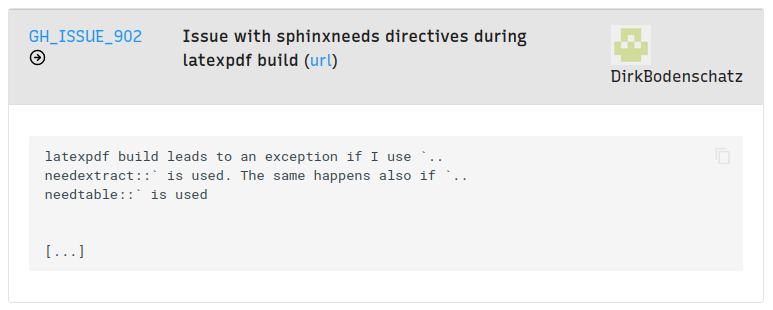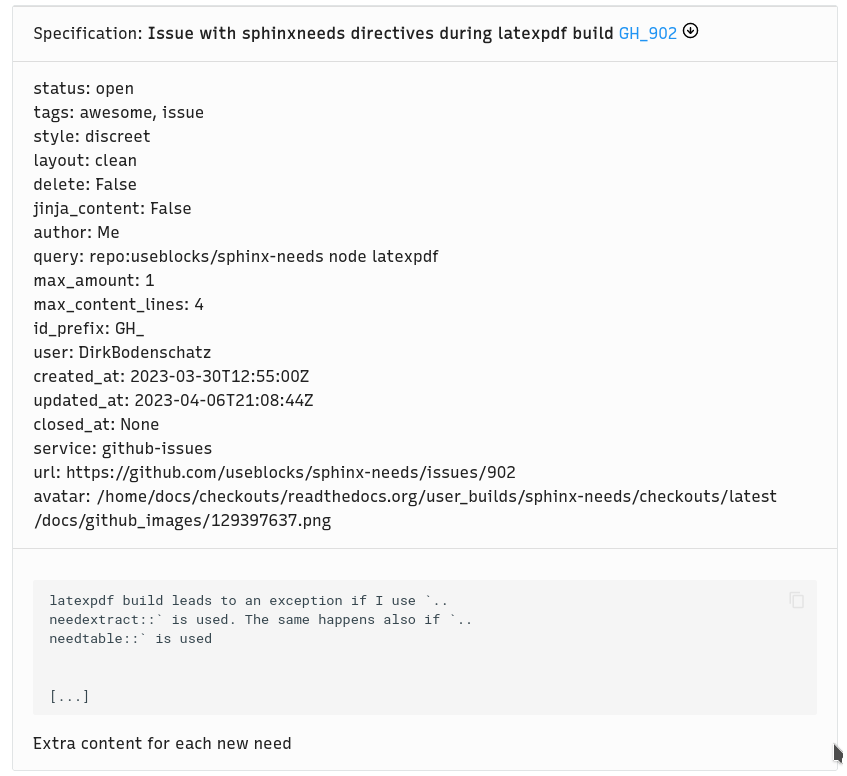GitHub services¶
As GitHub provides different kinds of information (e.g. issues, prs or commits), there is a specialised service for each information type:
github-issuesgithub-prsgithub-commits
They all have common configuration options and are using the same way of querying their data. Therefore the below configuration is valid for all three services.
Each services creates normally multiple need objects for each element found by querying the GitHub API.
Example of an imported github issue:
.. needservice:: github-issues
:query: repo:useblocks/sphinx-needs node latexpdf
:max_amount: 1
:max_content_lines: 4

Example of a github Issue collected with Sphinx-Needs.¶
Directive options, which can also used for normal needs, can also be set for needservice directive.
Also the content part of needservice is added as extra data to the end of the finally created needs.
Example:
.. needservice:: github-issues
:query: repo:useblocks/sphinx-needs node latexpdf
:id_prefix: GH_
:max_amount: 1
:max_content_lines: 4
:type: spec
:author: Me
:tags: github, awesome, issue, open
:layout: clean
:style: discreet
Extra content for each new need

Example of a github Issue collected with Sphinx-Needs.¶
Querying objects¶
There are two options for querying objects for GitHub:
query:Performs a Github search
specific:Gets a single, specific element from GitHub
Setting query or specific option is mandatory for services github-issues and github-prs!
Warning
GitHub counts the performed API requests and may reject new requests, if the rate limit is exceeded. This seems to be 10 requests per minute for search-API for unauthenticated users.
You can higher this limit to 30 requests, if you provide a username and token in the service config.
Sphinx-Needs will support you with the current rate limit status, if a request got rejected.
query¶
The imported objects are based on a query-string, which must be valid to the Github search syntax for issues and pull requests.
To query for issues only, github-issues adds is:issue to the query string automatically.
Related to this, github-prs adds is:pr.
Example:
This loads all open issues, which have the strings needtable and viewports in their data.
.. needservice:: github-issues
:query: repo:useblocks/sphinx-needs state:open needtable viewports
specific¶
If only a single, specific object shall be documented, using query will not work, as the GitHub Search API
does not support query-options for getting a specific element.
Instead use specific and provide the unique reference in the syntax owner/repo/number, for example
useblocks/sphinx-needs/155
Example:
This query fetches a specific pull request with the id 161.
.. needservice:: github-prs
:specific: useblocks/sphinx-needs/161

Example of a github Issue collected with Sphinx-Needs.¶
Common Configuration¶
All GitHub related services have a common set of configuration options and their configuration must be done in needs_services inside the project’s conf.py file.
needs_services must contain a key with the service name, e.g. github-issues
The following key-value configuration parameters are known by all GitHub services:
- url:
GitHub service instance url. Default:
https://api.github.com/- username:
Username if access to private repositories is needed.
- token:
Personal GitHub token for login. Can be created in your User profile page.
- download_avatars:
True/False, if avatars shall be downloaded. IfFalsea default avatar is used. Needed mostly forGitHub Enterprise, as authentication for avatars may make some trouble.- download_folder:
Folder path for avatar downloads. Default:
github_images.- need_type:
Default need type to use, if no type got specified in directive options
- max_amount:
The maximum amount of issues to report
- max_content_lines:
Maximum amount of lines from issue/pr/commit content to be reported in need content.
- id_prefix:
Prefix string for the final need id.
- layout:
Layout to use for need. Default is
github. See Layouts for details.
All options can be overwritten by setting them directly in the need service directive:
.. needservice:: github-issues
:query: repo:useblocks/sphinx-needs
:type: test
:max_amount: 10
:max_content_lines: 2
:id_prefix: GITHUB_UB_
Example configuration for conf.py:
needs_services = {
'github-issues': {
'url': 'https://api.github.com/',
'need_type': 'spec',
'max_amount': 2,
'max_content_lines': 20,
'id_prefix': 'GH_ISSUE_'
}
}
Layout¶
The GitHub services are providing a new layout, called github, which is used by default and is based on the
standard complete layout.
You can overwrite its usage by setting layout in the service configuration or by setting it directly in the
directive needservice.
.. needservice:: github-issues
:query: repo:useblocks/sphinx-needs node latexpdf
:max_content_lines: 4
:layout: focus_l
:style: blue_border

Example of a github Issue collected with Sphinx-Needs.¶
Need type¶
The GitHub services create 3 new need types: issue, pr and commit.
These types are used by default by the related service, but its usage can be overwritten in the service configuration
by setting need_type or in the directive directly by setting type.
The configuration (names, colors, diagram representation) can also be overwritten by configuring your own need type in the configuration. Simply use needs_types for this.
Custom service¶
The preconfigured services github_issues, github_prs and github_commits support the cloud instance of
GitHub by default.
If a company internal GitHub Enterprise instance shall be addressed, you should configure an additional service to
deal with both (cloud and company instance) and being able to set company specific configuration options.
Please see the this example for a Github Enterprise configuration in your conf.py file:
from sphinx_needs.services.github import GithubService
needs_services = {
# Cloud GitHub configuration
'github-issues': {
'max_content_lines': 20,
'id_prefix': 'GH_ISSUE_',
},
# GitHub Enterprise configuration
'my-company-issues': {
'class': GithubService,
'class_init': {
'gh_type': 'issue'
},
'url': 'https://github.my-company.com/api/v3/',
'username': 'my_username',
'token': 'my_github_token',
'download_avatars': True,
'download_folder': 'company-avatars',
'max_content_lines': 20,
'id_prefix': 'COMPANY_ISSUE_',
}
}
class needs to reference the service-class object and class_init contains service specific
initialisation options. In this case you must tell the generic GitHubService class which kind of information
it shall deal with. Allowed are issue, pr and commit.
All other options are normal configuration options for the service, which are also available for the GitHub cloud instance.
Examples¶
Commits¶
Search
Search for all commits of Sphinx-Needs, which have Python in their message.
.. needservice:: github-commits
:query: repo:useblocks/sphinx-needs python
:max_amount: 2
Specific commit
Document commit a4a596 of Sphinx-Needs.
.. needservice:: github-commits
:specific: useblocks/sphinx-needs/a4a596
Filtering¶
Show all needs, which have github as part of their service value.
.. needtable::
:filter: 'github' in service
:columns: id, title, type, service, user
ID |
Title |
Type |
Service |
User |
|---|---|---|---|---|
Issue with sphinxneeds directives during latexpdf build |
issue |
github-issues |
DirkBodenschatz |